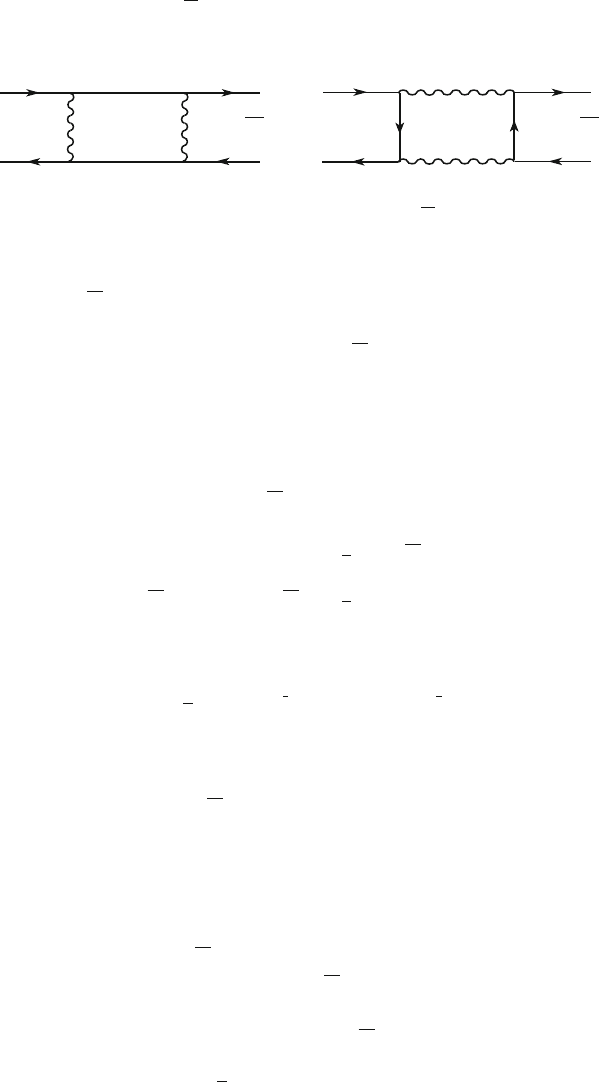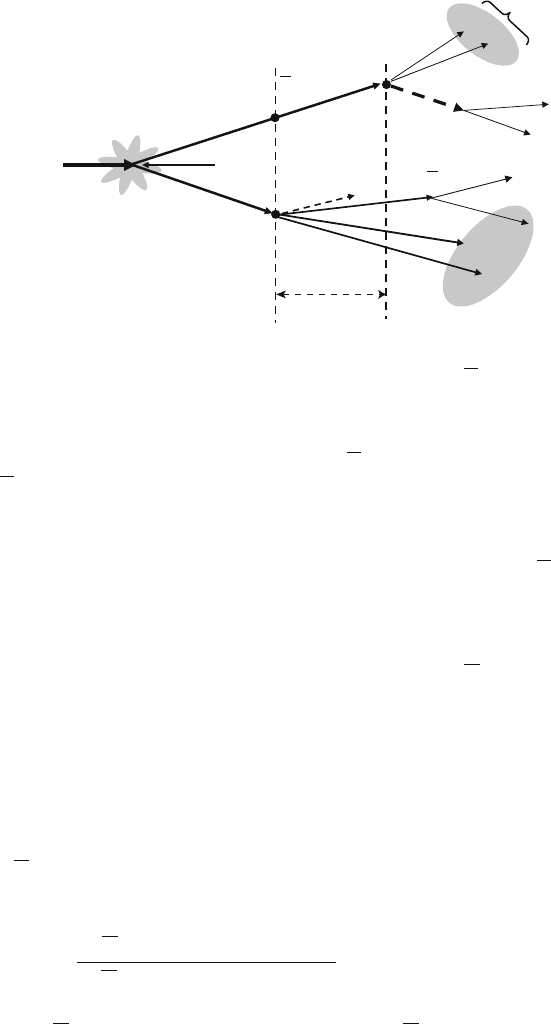Braibant S., Giacomelli G., Spurio M. Particles and Fundamental Interactions: An Introduction to Particle Physics
Подождите немного. Документ загружается.


12.5 CP-Violation in the B
0
B
0
System 361
B
0
B
0
b
u, c, t
d
W
W
WW
u, c, t
b
–
d
b
–
d
–
b
d
–
ab
B
0
B
0
u
–
,
c
–
,
t
–
u
–
,
c
–
,
t
–
Fig. 12.7 Box diagrams illustrating the transitions (mixing) B
0
$ B
0
mesons, the neutral B mesons have mass eigenstates different from the strong flavor
eigenstates B
0
, B
0
. The mass eigenstates are
jB
˙
iDpjB
0
i˙qjB
0
i : (12.32)
The kaon mass eigenstates are distinguished primarily by their lifetime, which
strongly depends on the energy available in the phase space. This quantity is
different for the decay into two or three pions. For the B mesons, the lifetimes
differ by a small amount and the states are distinguished primarily by their masses.
Starting at t D 0 with a pure B
0
or B
0
state, the time evolution is
jB
0
.t/iDg
C
.t/jB
0
iC
q
p
g
.t/jB
0
i (12.33a)
j
B
0
.t/iDg
C
.t/jB
0
iC
p
q
g
.t/jB
0
i (12.33b)
where
g
˙
.t/ D
1
2
e
iM
C
t
e
1
2
C
t
Œ1 ˙ e
iMt
e
1
2
t
(12.34)
and M DjM
C
M
j, Dj
C
j . This means that flavor eigenstates
oscillate with a time-dependent probability proportional to jg
˙
.t/j
2
.
Only a small fraction of B
0
; B
0
is subject to CP-violating decay. To observe these
interesting decays, an enormous number of B mesons must be produced through
dedicated accelerators called B-factories. The primary objective of B-factories is to
measure the parameters of the unitarity triangle and, in particular, the ˇ angle of
Fig. 12.6.
The specific process used to measure the ˇ angle is the time-dependent asymme-
try in the decay of a initial B
0
B
0
pair produced by the decay of the .4s/resonance
into a common CP eigenstate. The initial B
0
B
0
state evolves coherently until one
of the two mesons, which we call B
tag
, decays at t
1
in a final state f
tag
.IftheB
0
is
B
tag
(as in Fig. 12.8), the second meson must be a B
0
at the time t
1
, and it can decay
at a later time t
2
into a CP eigenstate, denoted as f
CP
. This state can be, for instance,
a J= (the meson formed by c
c)plusaK
S
(f
CP
D J= K
S
). This decay has a
BR 0:5 10
3
, and occurs about once in 2,000 cases. The B
tag
decay products

362 12 CP-Violation and Particle Oscillations
Υ(4S)
t
1
B
0
e
–
e
+
∼200 μs
μ
+
μ
–
μ
+
π
–
π
–
π
–
π
+
ν
μ
Κ
+
t
2
J/ψ
Κ
s
B
0
D
0
Fig. 12.8 At a B-factory, electrons and positrons collide with just enough energy to produce a
.4S/, which immediately decays (through strong interaction) to B
0
; B
0
.Thee
has a higher
energy than the e
C
(asymmetric collider), and thus the two B mesons move along the direction of
the electron beam before decaying within a few ps (10
12
s). The CP-violation is measured through
the B-meson decays to J= plus K
S
, followed by the J= decay into a muon pair and the K
S
decay into a pion pair. However, since either a B
0
or a B
0
can produce these decays (for instance,
the
B
0
at the time t
2
), the decay of the other B meson in the event must be accurately measured
(or tagged) in order to establish which is which. Here, the presence of a
C
in the vertex at t
1
identifies the B
0
through its semileptonic decay. The position at which the two B mesons decay
must be determined precisely in order to establish how long the particles lived between t
1
and t
2
.
The Standard Model predicts that, on average, B
0
mesons decay slightly later than B
0
mesons, by
an amount that depends on the angle ˇ of the unitarity triangle [12G07]
at t
1
must be tagged in order to establish if it is a B
0
or a B
0
. In the figure, the
presence of a
C
in the vertex at t
1
identifies the B
0
through its semileptonic decay
(see Problem 12.6).
The time interval t D t
2
t
1
(see Fig. 12.8) between the two decays is
measurable if the .4s/ is produced with a “boost” ˇ 1 along the collision
z-axis (which is achieved using asymmetric colliders). t can be determined from
the measurement of the z-distance between the decay vertices: t ' .z
2
z
1
/=ˇc.
The Standard Model predicts that, on average, B
0
mesons decay slightly later
than
B
0
mesons. This asymmetry can be calculated as a function of time; according
to the parameters of the CKM matrix (12.28), this asymmetry is
A.t/ D
.
B
0
! f
CP
/ .B
0
! f
CP
/
.B
0
! f
CP
/ C .B
0
! f
CP
/
D
CP
sin 2ˇ sin M
d
t (12.35)
where .
B
0
.B
0
/ ! f
CP
/ is the branching ratio for B
0
.B
0
/ in f
CP
D J= K
S
at
a certain time t after production,
CP
D˙1 is the CP eigenvalue of the f
CP
state,

12.5 CP-Violation in the B
0
B
0
System 363
Δt(ps)
–5 0 5
# of Events# of EventsAsymmetry
B
0
100
100
0
0
0
0.5
–0.5
B
0
a
b
c
Fig. 12.9 The B
0
; B
0
mesons behave differently when they decay. The decay rate of the B
0
(a)andB
0
(b) meson is described by an exponential curve. However, CP-violation, combined
with the B
0
; B
0
mixing properties, produces a sinusoidal modulation in the exponential decay.
This sinusoidal behavior changes sign between the B
0
and B
0
meson, observable in the shapes
of their decay rates. (c) Dividing the difference between the two decay rates by their sum, the
asymmetry which provides a direct measurement of the angle ˇ in the unitarity triangle is obtained
[12H03]
M
d
is the mass difference between the two mass eigenstates determined by the
B
0
B
0
mixing.
Measurements of the unitarity triangle parameters, and particularly of sin 2ˇ,
were recently performed by the Belle and BaBar collaborations. The Belle detector
is installed at the Japanese KEKB e
C
e
asymmetric collider, with 3.5 GeV positron
and 8 GeV electron beams [12A01]. The BaBar detector used the PEP-II facility at
Stanford (United States) where 3.1 GeV e
C
collided against 9 GeV e
[12D01].
The decay time difference distributions between events in which the tagging
is respectively due to a B
0
or a B
0
are shown in Fig. 12.9 for the BaBar data.
The asymmetry is clearly visible if the difference between the two distributions is
divided by their sum. The sinusoidal modulation was measured with a fit to the data.
The Belle and BaBar results are consistent within errors, and from the combination
of the two experiments [P08], the following measurement was obtained, that is,
sin 2ˇ D 0:681 ˙ 0:025: (12.36)
The value ˇ D 21:0
ı
˙ 1:0
ı
is compatible with that obtained from the CP-
violation in a neutral kaon system. The remaining angles of the unitarity triangle,
364 12 CP-Violation and Particle Oscillations
involving other elements in the CKM matrix, are more difficult to measure. For
instance, sin 2˛ cannot be simply measured tagging the B
0
!
C
decay, as the
asymmetry in this decay is not simply proportional to sin 2˛. The third angle, ,
may be determined by measuring the asymmetry in the B
0
! DK decay (where D
is a meson containing a c quark). However, the measurement is extremely difficult
because of the small branching ratio (BR) in this channel (BR 10
6
). The value
of the two angles are ˛ D 92
ı
˙7
ı
and D 82
ı
˙20
ı
[12G07]. Within errors, the
sum of the three angles is equal to 180
ı
.
The CP-violation parameter in (12.28) can be estimated not only from the
measurements of the unitarity triangle angles, but also from the triangle area. The
triangle sides are proportional to the number of decays in the appropriate channels.
From the experimental point of view, the measurement of the R
u
side, between
the ˛ and angles, is extremely difficult because of the small value of the matrix
element: jV
ub
jD.3:5 ˙ 0:2/ 10
3
(see Fig. 12.6). This implies that a B meson
decay into mesons containing an up-quark is extremely rare (see also Fig. 8.20). The
measurement of the R
t
side, between the ˛ and ˇ angles, involves the very small V
td
matrix element for the transition of a meson with a t-quark into mesons with a d-
quark. The energies involved in B-factories are actually too low to produce mesons
containing a t-quark; this channel can only be studied at higher energy colliders.
12.5.1 Future Experiments
The LHC will provide more information about the CP-violation in the B sector. The
BaBar and Belle experiments detected millions of B-mesons per day; the expected
rate at the LHC will be of the order of 10
6
mesons per second. The LHCb experiment
(one of the four detectors installed at the CERN LHC collider) will measure the
unitarity triangle parameters with high precision, and in particular, the angle.
The proton-proton collisions, however, intrinsically have a much higher background
event rate with respect to e
C
e
machines and the interesting events will be more
difficult to select.
Waiting for the LHC results, the matter-antimatter asymmetry observed in the
Universe stimulates new experimental ideas. A Super flavor Factory, which is an
asymmetric e
C
e
collider similar to the current B-factories with a 100 times larger
luminosity, was proposed by the international scientific community for precision
measurements of the unitarity triangle parameters.
12.6 Neutrino Oscillations
The Standard Model of the microcosm includes three flavors of massless and left-
handed neutrinos, denoted as
e
;
;
; a neutrino of one type cannot transform into
a neutrino of another type. Three degenerate massless particles are surprising and

12.6 Neutrino Oscillations 365
cannot explain the difference amongst themselves and the reason for the L
e
;L
;L
lepton number conservation. In some Grand Unified models (the theory suggesting
the unification of the electroweak interaction with the strong one, Chap. 13),
neutrinos have nonzero masses (although small) with a possible relation of the
type m
e
W m
W m
D m
2
e
W m
2
W m
2
. The possibility of neutrino oscillations
(in fact, •
) was first suggested by Bruno Pontecorvo in 1957. The possible
transformation of a neutrino of a given flavor into a different flavor was only
proposed later. As a consequence of this hypothesis, the neutrino should have a
nonzero mass. Neutrino mixing and oscillations can be formally treated in the same
manner as already seen for the K
0
K
0
, B
0
B
0
systems.
It is not correct to speak of
e
;
;
masses. The
e
;
;
states are defined as
weak flavor eigenstates which must be considered in particle decays (for example,
in
C
!
C
) and in particle interactions (e.g.,
n !
p). For the neutrino
propagation, we shall consider the mass eigenstates denoted as
1
;
2
;
3
. According
to quantum mechanics, the flavor eigenstates, j
f
i (f D e; ; ), are linear
combinations of mass eigenstates j
j
i (j D 1; 2; 3):
j
f
.t/iD
X
j
U
fj
j
j
.t/i: (12.37)
In vacuum, the mass eigenstates j
j
i propagate independently, that is,
j
j
.t/iDe
E
j
t
j
j
.0/i: (12.38)
For a given momentum, the eigenstates j
j
i propagate with different frequencies:
in (12.38), the energies E
j
D
p
p
2
C m
j
(in natural units) of the mass eigenstates
are slightly different for
1
;
2
;
3
for nondegenerate massive neutrinos.
12.6.1 The Special Case of Oscillations Between Two Flavors
Let us consider the simplest case of only two neutrino flavors, for example, the
pair
2
;
. Each state is a linear combination of the two mass eigenstates
2
;
3
.
The flavor and mass eigenstates are related by a unitary transformation with one
mixing angle , namely,
!
D
cos sin
sin cos
!
2
3
!
: (12.39)
2
The same formalism applies to
e
;
or
e
;
x
, with x D ; .

366 12 CP-Violation and Particle Oscillations
Then,
(
j
iDcos j
2
iCsin j
3
i
j
iDsin j
2
iCcos j
3
i
: (12.40)
The flavor eigenstates
;
are generated in decay processes (and can be observed
when they interact); the propagation in vacuum is determined by the energies of the
mass eigenstates (12.38), that is,
(
j
2
.t/iDe
iE
2
t
j
2
.0/i
j
3
.t/iDe
iE
3
t
j
3
.0/i
: (12.41)
Consider the case in which, at t D 0, only
are present (produced, for instance, in
charged pion decays), that is,
(
j
.0/iDcos j
2
.0/iCsin j
3
.0/i
j
.0/iDsin j
2
.0/iCcos j
3
.0/iD0
: (12.42)
From these relations, with simple algebra, one can derive
(
j
2
.0/iDcos j
.0/i
j
3
.0/iDsin j
.0/i
: (12.43)
At any successive time t, from (12.40), one has
j
.t/iDcos j
2
.t/iCsin j
3
.t/i: (12.44)
Placing (12.41)into(12.44), one obtains
j
.t/iDcos e
iE
2
t
j
2
.0/iCsin e
iE
3
t
j
3
.0/i; (12.45)
and using (12.43), one finally gets
j
.t/iDcos
2
e
iE
2
t
j
.0/iCsin
2
e
iE
3
t
j
.0/i: (12.46)
The probability density is obtained by multiplying (12.46) by its complex conjugate,
that is,
jh
.t/j
.t/ij D I
0
fcos
4
C sin
4
C sin
2
cos
2
Œe
i.E
3
E
2
/t
C e
i.E
3
E
2
/t
g
D I
0
1 sin
2
2 sin
2
.E
3
E
2
/t
2
(12.47)
where I
0
Djh
.0/j
.0/ij D 1. Given the small neutrino mass (m
j
E
j
),
E
j
' p C
m
2
j
2p
. The momentum p is the same for the two mass eigenstates, and thus

12.6 Neutrino Oscillations 367
E
3
E
2
' .m
2
3
m
2
2
/=2p ' m
2
=2E (12.48)
with m
2
D .m
2
3
m
2
2
/. Equation 12.47 represents the probability that the
remains a
at a given time t,thatis,jh
.t/j
.t/ij D P.
!
/.The
probability that the
transforms itself into a
is P.
!
/.Thesetwo
probabilities are
8
ˆ
ˆ
ˆ
<
ˆ
ˆ
ˆ
:
P.
!
/ D 1 sin
2
2
sin
2
E
3
E
2
2
t
D 1 sin
2
2 sin
2
L
L
osc
P.
!
/ D 1 P.
!
/ D sin
2
2 sin
2
L
L
osc
(12.49)
where
L
osc
D
4p
m
2
'
4E
m
2
D 2:48[km]
E[GeV]
m
2
[eV]
2
: (12.50)
is the neutrino oscillation length, m
2
is expressed in eV
2
, L ' ct is the distance
(in km) between the
production and the
(or equivalently the
) observation
points; the neutrino energy E is in GeV. The factor 2.48 results from this choice of
units. Thus in (12.49)
L
L
osc
D
1:27
m
2
[eV]
2
L[km]
E[GeV]
:
To observe the largest
disappearance (or
appearance) the argument of the sine
must be equal to =2.ForE ' 1 GeV, m ' 0:05 eV, the distance between the
observer and the neutrino production point must be L ' 10
3
km.
There are no theoretical estimates for ; the first guess was '
C
,where
C
is the small Cabibbo angle. However, we shall see that neutrino oscillation experi-
ments show that the angle is near maximum for the sin
2
2 function, i.e., 45
ı
.
12.6.2 Three Flavor Oscillations
In the case of three flavors, the mixing between flavor and mass eigenstates is
described by the 3 3 unitary matrix (12.37). As for the mixing among quarks,
the unitary matrix can be parameterized as (8.62b), which is reported here for
simplicity
3
as
3
The neutrino mixing matrix differs from that of quarks since there are, in addition to a phase
angle that would allow the CP-violation in the leptonic sector, two other phase angles. They
have consequences if the neutrino is a Majorana particle, namely, if the neutrino is identical to
its antiparticle. This problem is not described here but detailed explanations can be found in [P08].

368 12 CP-Violation and Particle Oscillations
Table 12.1 Experiments for neutrino oscillations. The columns report: the source of neutrinos;
some of the most significant experiments; the section in the book where they are described; the
neutrino flavour at the source; the mean path length from the source to the detector; the minimum
value of m
2
which can be measured
See Neutrino EL m
2
min
Source Experiments Sect. Type (GeV) (km) (eV
2
)
Reactor
1
Chooz, ... 12.9
e
10
3
1 10
3
Reactors KamLand 12.7
e
10
3
100 10
5
Accelerator Chorus, Nomad 12.8.1
;
1 1 1
Accelerator K2K, MINOS, Opera 12.8.1
;
1 300–700 10
3
Atmospheric
2
SK,Soudan 12.8
;e
;
;e
1 10–10
4
10
1
–10
4
Atmospheric
3
SK,MACRO 12.8
;
10 10
2
–10
4
10
1
–10
3
Sun SK,SNO,Gallex,... 12.7
e
10
3
10
8
10
11
1
Chooz and Palo Verde are concluded. Double Chooz, Daya Bay and Reno are in preparation. They
are mainly devoted to measure the
13
mixing angle.
2
The neutrino flavour is detected from the contained event topology.
3
Measured by
-induced upgoing muons
U
fj
D
0
B
@
c
12
c
13
s
12
c
13
s
13
e
iı
s
12
c
23
c
12
s
23
s
13
e
iı
c
12
c
23
s
12
s
23
s
13
e
iı
s
23
c
13
s
12
c
23
c
12
s
23
s
13
e
iı
c
12
s
23
s
12
c
23
s
13
e
iı
13
Cc
23
c
13
1
C
A
(12.51)
(the usual abbreviations, e.g., s
13
D sin
13
, are used). The numerical values of
the matrix components were measured in various experiments. The possibility of
CP-violation in the leptonic sector is introduced by a phase parameter, ı,which
presently is unknown. The possibility of its future measurement depends on the
value of s
13
, which determines the CP-violation amplitude.
Convincing experimental evidence for neutrino oscillations exists in:
• Atmospheric neutrinos (
!
), that is, neutrinos produced by the interaction
of cosmic rays with the atmosphere;
• Solar neutrinos, i.e., electron neutrinos produced by nuclear reactions in the Sun;
• Muon neutrinos produced at accelerators, with detectors placed at L ' 250 km
and '735 km;
• Electron antineutrinos from nuclear reactors, with L 180 km.
The experimental results (see Table 12.1 for the minimum m
2
value that can be
tested) discussed in the following sections can be treated with good approximation
with the formalism of two flavor oscillations if one of the mass eigenvalues is much
larger than the other two.
12.6.3 The Approximation for a Neutrino with Dominant Mass
The more general formulas for the probability of three flavor neutrino oscillations
are rather complicated [12L01]. They are obtained from (12.37), with the matrix U

12.6 Neutrino Oscillations 369
with three mixing angles and one complex phase presented in (12.51). The formulas
can be greatly simplified if there is a hierarchy between the neutrino masses, for
example,
m
3
m
2
>m
1
; (12.52)
yielding to (see also Fig.12.17)
jm
2
13
j'jm
2
23
jjm
2
12
j: (12.53)
In this situation, there are basically two characteristic oscillation lengths given by
(12.50), and that involving jm
2
12
j .L
12
' E=m
2
12
) is longer. In this case, there is
a range of E and L values such that short fluctuations (i.e., those relating to jm
2
23
j)
are active, while the long oscillation have not yet developed. The probability of short
oscillation can be approximated by
P.
˛
!
ˇ
/ D 4jU
˛3
j
2
jU
ˇ3
j
2
sin
2
m
2
13
4E
L
: (12.54)
This formula is similar to the two flavor oscillations (12.49), and the probability
oscillates with a single frequency, related to the mass difference jm
2
13
j'jm
2
23
j.
The amplitude probabilities only depend on the elements of the third column of the
mixing matrix U . Explicitly, one has
P.
e
!
/ D 4jU
e3
j
2
jU
3
j
2
sin
2
m
2
13
4E
L
D s
2
23
sin
2
2
13
sin
2
m
2
13
4E
L
(12.55a)
P.
e
!
/ D 4jU
e3
j
2
jU
3
j
2
sin
2
m
2
13
4E
L
D c
2
23
sin
2
2
13
sin
2
m
2
13
4E
L
(12.55b)
P.
!
/ D 4jU
3
j
2
jU
3
j
2
sin
2
m
2
13
4E
L
D c
4
13
sin
2
2
23
sin
2
m
2
13
4E
L
:
(12.55c)
As we shall see in the discussion of experimental data (Sect. 12.8), condition (12.53)
is verified. Results from atmospheric neutrinos (atm) and solar neutrinos (ˇ)
demonstrated that m
2
atm
m
2
ˇ
. In addition, the current experimental results
provide a very small
13
(<10
ı
). Thus, in Eq. 12.55,thetermsin
2
2
13
0 and
only the third equation is nonvanishing.
The situation described by (12.55c) corresponds to the atmospheric neutrino
oscillations, where jm
2
13
j'jm
2
23
j'm
2
atm
and
23
'
atm
. In the case

370 12 CP-Violation and Particle Oscillations
ν
e,μ,τ
ν
e,μ,τ
ν
e
ν
e
e
–
e
–
e
–
e
–
W
±
Z
0
ab
Fig. 12.10 Feynman diagrams for (a)the
e
,
and
scattering on electrons through a neutral
current weak interaction and (b) the charged current scattering of a
e
on e
of atmospheric neutrinos, muon neutrinos oscillate into tau neutrinos, while the
electron neutrinos are practically not affected by oscillations.
The other extreme case corresponds to the situation where
m
2
13
4E
L 1 (always
assuming m
2
13
' m
2
23
). This situation corresponds to the detection of electron
neutrinos from a nuclear reactor (e.g., KamLAND); the short oscillations are active,
and the quantity x D .m
2
13
L=4E/ ' .m
2
23
L=4E/ is the argument of the sin
2
.x/
function. Because x 1,sin
2
.x/ is rapidly oscillating, and only its average value
is effective. In this case, long-type oscillations are observed, where the electron
neutrino survival probability is given by
P.
e
!
e
/ ' c
4
13
P C s
4
13
(12.56)
with
P D 1 sin
2
2
12
sin
2
m
2
12
4E
L
: (12.57)
Because of the small value of
13
in (12.56), c
4
13
' 1; s
4
13
' 0 and the electron
neutrino oscillations can be described by the same formula used for two flavor
oscillations.
Note that oscillations of electron neutrinos were first observed using solar
neutrinos rather than reactor neutrinos. However, a complication is present for solar
neutrinos since their propagation occurs not only in vacuum (on their way to the
Earth), but also inside matter, that is, from the Sun core to the Sun surface.
12.6.4 Neutrino Oscillations in Matter
When neutrinos propagate in matter, the different behavior of
e
with respect to
and
must be taken into account. For a full discussion, see [B89]. The Feynman
diagrams with a Z
0
exchange are the same for
e
,
and
; the diagram with
W
˙
exchange only exists for the
e
(see Fig. 12.10). This different contribution to
